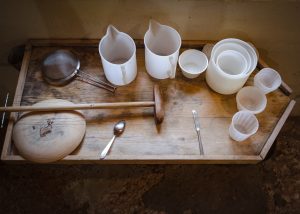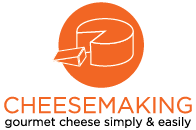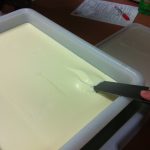 For home cheesemakers, understanding the role of calcium in milk used to make cheese is one of the keys to crafting delicious, high-quality cheeses.
For home cheesemakers, understanding the role of calcium in milk used to make cheese is one of the keys to crafting delicious, high-quality cheeses.
Milk for making cheese can vary in quality and composition; sometimes that variation is only minimal, but at other times variations can be quite substantial. Adding calcium chloride is a step that most cheesemakers recognise as being crucial to the formation of a good curd set, which then follows on to the quality of the finished cheese.
The Basics
Milk is a complex emulsion, with calcium playing a vital role in its structure. In milk, calcium exists in two main forms:
Soluble Calcium
Soluble calcium is dissolved in the milk serum. The serum is the liquid part of milk. This form of calcium is not attached to any other molecules and floats freely in the milk’s liquid. Soluble calcium helps maintain the balance between milk’s liquid (whey) and solid (curds) components.
Only soluble calcium is immediately available to participate in micelle bridging during renneting. If soluble calcium is low (e.g., due to pasteurisation, cold storage, or seasonal factors), micelles won’t aggregate well, and:
-
- Curd formation is slow or incomplete
- Curd is weak, soft, or crumbly
- Whey separation is poor
Colloidal calcium
Colloidal calcium in milk refers to calcium that is part of large, suspended particles (micelles), rather than dissolved freely in the liquid. Most of this colloidal calcium in milk is present as colloidal calcium phosphate, very small, amorphous (non-crystalline) clusters of calcium and phosphate ions held within the structure of the casein micelles.
Calcium phosphate is a general chemical term for compounds made of calcium and phosphate ions. In milk and it is found both dissolved in the liquid (soluble) and as part of the colloidal micelle structure.
The coagulation of casein micelles is required to form a curd and this depends on the complex structures that consist primarily of casein proteins (αs₁-, αs₂-, β-, and κ-caseins), calcium phosphate, and water. These micelles are stable in milk thanks to κ-casein, which forms a hairy, negatively charged outer layer that repels other micelles, preventing them from clumping together.
 Reasons that cheesemakers add calcium chloride to cheese milk.
Reasons that cheesemakers add calcium chloride to cheese milk.
- Calcium chloride assists curd formation by stabilising casein micelles thus reinforcing the structure of casein proteins which in turn helps form a strong curd.
- The texture and consistency of having stronger curds lead to a smoother, more uniform cheese texture.
- This then creates an increase in yield with fewer milk solids being lost in the whey
How much calcium form the calcium chloride are you adding to the cheese milk?
A 100 ml bottle of 33% calcium chloride solution contains only soluble calcium. There is no colloidal calcium present in that bottle. Calcium chloride is highly soluble in water and does not form colloidal particles in this context. There are 33 grams of CaCl₂ per 100 ml of CaCl₂ solution. The actual soluble calcium in that 100ml is approximately 12g. So, if you add 5ml of CaCl₂ to 10 litres cheese milk you are adding 0.6 g of soluble calcium.
However, when you add CaCl₂ to warm milk during cheesemaking, it will affect the calcium balance, the calcium ions that you added can now interact with the existing casein proteins in the milk which already contain colloidal calcium. At this point, the setting of the milk is enhanced. The addition of soluble calcium has strengthened the micelle structure, aiding in the texture and firmness of the cheese. In a typical cheesemaking process, it is ideal to allow around 30 to 60 minutes after adding CaCl₂ before you add the rennet, for the calcium ions to complete their interaction with the casein micelles within the milk. I was once told by a renowned French cheesemaker that if you add CaCl₂ immediately before you add the rennet, you may as well pour it into the sink. The warm temperature and some acid production in the cheese milk from the starter cultures can also increase the rate of this interaction.
How much of the calcium in milk is colloidal and how much of it is soluble?
Cold storage increases the solubility of calcium phosphates, causing some colloidal calcium to dissociate from casein micelles and become soluble ionic calcium in the milk serum. The total calcium (sum of colloidal and soluble) remains stable; it is the distribution that changes. The shift from colloidal to soluble calcium in milk during cold storage usually progresses over time so the longer the milk is stored cold, the greater the decrease of colloidal calcium. Variations of soluble and colloidal calcium depends on what stage of the milk life cycle you use that milk to make cheese.
1) Straight from the Cow (Fresh Raw Milk)
- Colloidal calcium: About 65–70% of the total calcium is in the colloidal form, mainly as colloidal calcium phosphate bound to casein micelles.
- Soluble calcium: About 30–35% is soluble, present as free ions (Ca²⁺) and calcium salts (e.g., calcium citrate, calcium phosphate) in the milk serum.
- Typical concentrations: Fresh cow’s milk contains about 1,200 mg/L total calcium, with roughly 800 mg/L colloidal and 400 mg/L soluble.
For the 10 litre example mentioned earlier: 10 litres of fresh cow’s milk contains about 12,000 mg total calcium, with roughly 8,000 mg being colloidal and 4,000 mg being soluble. By adding 5ml of CaCl₂ to 10 litres of warm cheese milk, you are supplementing the original calcium with 0.6 grams (600mg) of soluble calcium. A small amount of calcium, but a very important addition.
2) 24 Hours After Cold Storage on the Farm
- Colloidal calcium: Remains largely unchanged in the first 24 hours if the milk is cooled quickly and kept cold (below 4°C/39°F), as the casein micelles remain stable.
- Soluble calcium: Also remains stable, though a very slight shift from colloidal to soluble, but this is minimal.
3) Immediately After Pasteurisation
- Colloidal calcium: Pasteurisation (usually at 72°C for 15 seconds) can cause some of the colloidal calcium phosphate to dissolve, slightly increasing the soluble calcium fraction.
- Soluble calcium: Increases slightly due to the temperature-driven shift but the total calcium content is not changed by pasteurisation.
4) Cold Stored for a Few Days After Pasteurisation
- Colloidal calcium: The colloidal/soluble balance returns to near-original levels after cooling.
- Soluble calcium: If the milk’s pH drops due to starter culture producing lactic acid (even in pasteurised milk), more colloidal calcium phosphate can dissolve, increasing the soluble calcium fraction. This is usually a slow process in well-refrigerated milk, but it becomes more pronounced if the milk starts to sour.
What happens when you add rennet to cheese milk
When rennet is added to milk, the soluble calcium causes the casein proteins to coagulate, trapping fats and other solids to form curds. Soluble calcium facilitates this coagulation by strengthening the bonds (the glue) between casein micelles, leading to effective curd formation. During the cheesemaking process, this balance is crucial for the formation of the cheese curds.
Why do you need to add calcium chloride to milk
 Not all milks are the same each time you make cheese. There are several variables that may cause soluble calcium to not be at the right level in your cheese milk, these are:
Not all milks are the same each time you make cheese. There are several variables that may cause soluble calcium to not be at the right level in your cheese milk, these are:
- Pasteurisation heats the milk, causing protein denaturation, which can alter the structure of casein micelles. This may affect how these casein micelles interact with calcium, despite an increase in soluble calcium. Although pasteurisation might increase soluble calcium, the denatured proteins may not respond as effectively to rennet, which will reduce the rennet’s ability to form a firm curd.
- pH changes, either through direct acidification, eg mozzarella or starter cultures, or even natural souring, make more calcium dissolve out of the micelles into the liquid.
- Composition of the milk for different species (eg cow, goat, sheep) with different breeds within that species and with different individuals within that breed. Also, seasonal or dietary changes in the animal’s feed can alter how much calcium is naturally present and how it’s distributed between soluble and colloidal forms
Raw Milk: A Natural Exception
For home cheesemakers using raw milk from a healthy lactating cow, the natural calcium balance remains intact, as raw milk does not undergo the heat treatment that can disrupt protein and calcium interactions. This means the natural calcium balance in raw milk remains, making calcium chloride addition unnecessary, as proteins are already primed for effective curd formation.
Impact on Different Cheese Types
- Soft Cheeses (e.g., Brie, Camembert):
- Texture Sensitivity: Soft cheeses are particularly sensitive to changes in calcium levels. Lower colloidal calcium can lead to overly soft or runny textures, which may affect the aging process and final creaminess.
- Hard Cheeses (e.g., Cheddar, Parmesan):
-
- Curd Firmness and Aging: Hard cheeses rely on a firm curd structure for proper aging and texture development. Reduced calcium may result in a weaker curd, affecting the final texture and potentially leading to uneven aging.
- Stretched Curd Cheeses (e.g., Mozzarella):
-
- Yield and Stretchability: Fresh cheeses like mozzarella require optimal calcium for stretchability and texture. Insufficient calcium can reduce yield and affect the cheese’s ability to stretch.
- Blue Cheeses (e.g., Stilton, Roquefort):
-
- Mould Growth: While calcium primarily affects curd formation, it can indirectly influence how blue mould develops in blue cheeses by affecting the initial curd structure.



